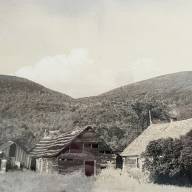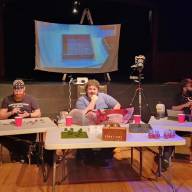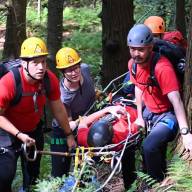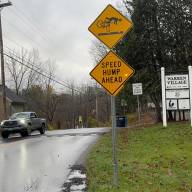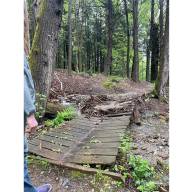By Jack Locker
My name is Jack Locker, I’m a first-generation Vermonter born in Burlington, at the turn of the millennia and I’m an environmental studies student at the University of Vermont planning to graduate in Spring 2024. I’m currently interning with the Conservation Commissions of Warren, Waitsfield, and Fayston physically removing the invasive plant species; knotweed (Reynoutria japonica).
Knotweed is an invasive plant from Japan that was introduced as an ornamental in North America in Yorkville, New York, in September 1873. Unfortunately, the plant escaped herbariums and cultivated human landscapes, spreading throughout New England. The impacts of the plant’s proliferation was not fully understood, and it expands across the landscape, endangering both human infrastructure and ecosystem biodiversity. Knotweed’s impressive capabilities as an invasive species is primarily due to its root network that increases erosion and actively prevents the growth of other species.
My work, amongst seven other UVM interns, is pulling, cutting, and digging knotweed in the hopes that over time our efforts will weaken the plant to allow for native species to become more prevalent. Many areas throughout Vermont, the Mad River included, have significant knotweed infestations and folks are doing their best to find ways to care for the health of their waterways. My role in this ongoing effort is to the limit the spread and raise awareness about the risks of inaction.
With much of this internship being physical labor, I’ve often found myself thinking about my motivations to engage with this work. I’ve wondered about the values underpinning my desire to care for places, the values motivating my fellow interns, and the ethos inspiring members of the Mad River Valley community in their conservation work.
As a white man of privilege raised in Vermont my perspective of conservation, knotweed, and my land ethic in general has been heavily influenced by my upbringing here and western culture. I’ve been both consciously and unconsciously told a story of humanity’s separation from the rest of life, which for most of my existence has rationalized the degradation of the world around me. I’ve been taught to see the world as happening outside of my being, that I am simply an observer of chaos and if I am to act as a participant, it is to perform a role that seeks to constrain the creativity of the world and create order out of life’s “messiness.”
My work with knotweed has afforded me the opportunity to reflect on this paradigm of human-nature relationship, particularly how, as a human, I’m a social being who defines myself by relationships with people and places to help make meaning of my time on this planet. I think about how conserving places simply for the resources they provide to humans neglects the inherent value all species have unto themselves. As I’ve worked along the banks of the Mad River, listening to the rush of the water, chirps of birds, and lost myself in the patterns of rocks and plants, I can’t help but become immersed in all the plant and animal creatures who are graciously co-creating every moment of existence alongside our species.
Although my experiences with this work have been limited, I’ve encountered reasons to steward an environment or care for a place and found that those which resonate most with me orient around the spirit of reciprocity. We all rose from the Earth, birthed by human mothers, nurtured by land on a planet adrift amidst a cosmic sea of unknowns so shouldn’t I return something to the web of life that has allowed for my existence? Earth may exist in a vacuum, but our species doesn’t. We rely on an incomprehensible network of interspecies relationships that clean water, grow food, and provide meaning to our lives.
Reflecting on this interdependency and my role as a descendant of privileged white people, I can’t help but find comparisons between myself and invasive species. As knotweed infests the banks of waterways, pushing out native species, increasing erosion, and making the land more hospitable for itself, my western culture of domination simultaneously seeks to alter the environment for human benefit at the expense of native species and ways of being. This raises the question: Who am I to demonize a plant whose proliferation mirrors that of my society?
I don’t believe that I should condemn the plant or my culture in entirety for the exploitation of resources that has allowed both to expand relatively unimpeded as this has occurred through the biological necessity of self-preservation. Just as knotweed produces feelings of fear and intimidation as to how we can control the plant, so too does the prospect of reorienting western cultures’ relationship with the world to exist within the planetary boundaries of resource availability. Hiding within the shadow of the future is more than doom and gloom as all it truly masks is the untapped potential to discover solutions for healthy people and places.
Instead of giving up and allowing a knotweed monoculture to dominate every brook, stream, river, and waterbody in the state, I’m learning to examine the box of assumptions that has been constructed to hold my understanding of what it means to interact with a place. Knotweed has taught me how attempting to impose a preconception of how a landscape should be is an ego-centric miscalculation of the creativity nature possesses. The plant and people are here to stay, however, the impact both have is only limited by our creativity and willingness to act.
I want to acknowledge that living on Earth in this moment of climate catastrophe evokes feelings of grief, despair, and powerlessness that are exacerbated by our access to nearly infinite information. We need each other, the plants, animals, soil, fungi, microorganisms and so much more if we are to give future generations the opportunity to experience a healthy web of life. Knotweed has the power to act as a catalyst to bring people together to authentically feel the gravity of our circumstances and to create the future we want to pass on.





